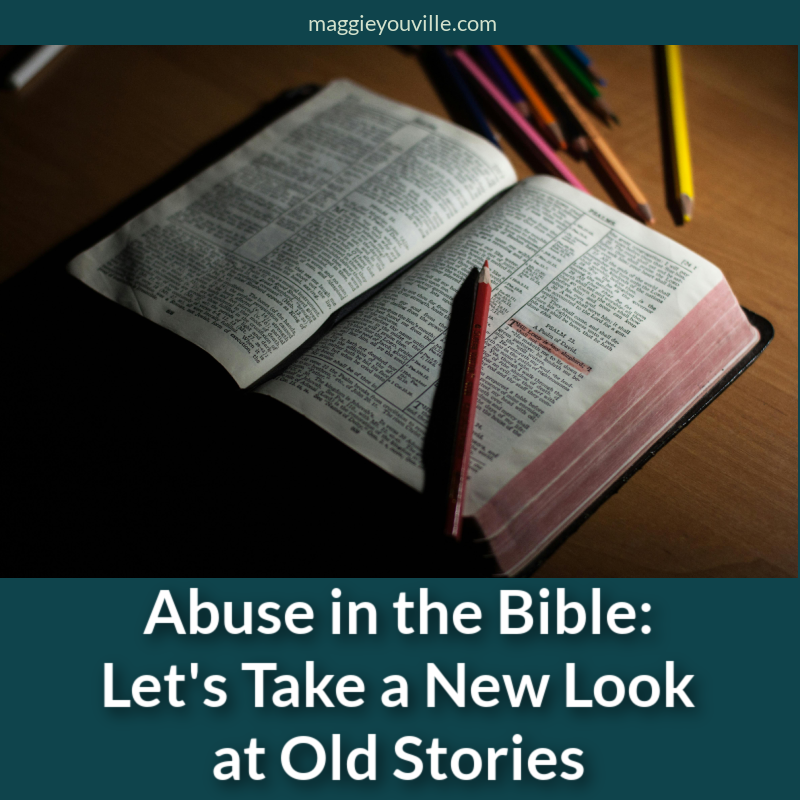Many of us have grown up hearing familiar Bible stories over and over again. We know the story of Noah’s Ark, of Joseph’s multi-coloured coat, of the Prodigal Son, and may wonder how these stories apply to our own lives. As we struggle to understand the abuse we’re living with, it may seem that the Bible has nothing to offer us beyond nice kids’ bedtime stories.
However, there are numerous stories within the Bible that present a compelling picture of abuse–a picture of God not only allowing a victim to leave an abuser, but of God himself rescuing victims from their abusers. These stories can help us to have a better understanding of how abuse should be handled and how deep is the Father’s love and concern for those in harmful relationships.

Reading the Bible Well
When looking at Bible stories, we need to recognize two things. First, the authors of the Bible present the bare facts. There is no commentary, no interpretation, no judgement offered. We are simply given the story–or, to look at it another way, the story outline–and left to draw our own conclusions. Often, we’ve heard these stories so many times over that we are no longer shocked or curious about the stories.
Second, these stories were written in ages and cultures very different from our own. We should be very careful about projecting twenty-first century values and ideas onto men and women who lived thousands of years ago. Their situations and beliefs were very different than ours, and we need to consider that when considering their stories.
Many stories in the Old Testament unfortunately show women being treated very badly. We need to guard against becoming desensitized to the pain in these stories or to think that this inhumane treatment is somehow “spiritual” or okay because it is in the Bible. Instead, many of these stories show us the raw reality of evil.
The USCCB acknowledges, “A correct reading of Scripture leads people to an understanding of the equal dignity of men and women and to relationships based on mutuality and love. Beginning with Genesis, Scripture teaches that women and men are created in God’s image. Jesus himself always respected the human dignity of women.”
Broken Families, Redeeming Stories
Father Mike Schmitz’s Bible in a Year podcast hit the number one spot on iTunes the same year I left my abusive husband. After hearing about it over and over again, I finally decided to give it a listen somewhere near the end of January. As Father Mike read through Genesis and Exodus and on into the judges and prophets, I found myself weeping frequently. In the Old Testament, I heard stories of broken families. Pain. Hurt. Betrayal. Generational trauma. Abuse.
And through it all… hope. God redeeming his people over and over again. No matter how many mistakes they made, how many times they didn’t listen to him, God continued to reach out to his people, to bring about better things in their lives. And because I know the end of the story, I also know that all these broken, hurting, hurtful people are part of Jesus’ genealogy.
As Aimee Bird says, “Can we uncover ourselves from these veils and show our bareface? That’s what Scripture does for us, right? It’s all there. There are no forced smiles, no tidy bows at the end of the narratives. The history of God’s people reveals all the depravity, all the disordered desire, all the loneliness, all the aching, all the disillusionment, intertwined with the wonder and love and glory of God and humanity.”
Meditate on the Bible Stories
St. Ignatius of Loyola taught a method of meditation that can be useful when reading the Bible. Catholic Identity explains, “He believed that our imagination can help us to enter into the events of Jesus’ life. Take a scripture passage and then imagine you have the opportunity to dialogue with the teacher [or main character] in the story.” This method of carefully, thoughtfully, and imaginatively reading familiar Bible stories can help us look past the outline given and really think about what each character thought, believed, and experienced.
Come with me to explore some well-known Bible stories from an abuse-informed perspective. Let’s take another look at what is happening here, using both our imaginations and current research on the Bible, and see what we can gain by letting the men and the women of the Bible speak to us in a new way.
Leave a Reply